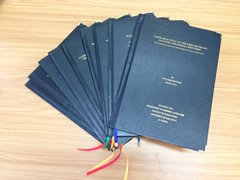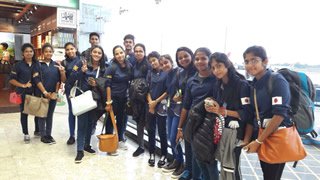Smiles that Left an Impression
University of Kelaniya
KOMATSUBARA Naho
Sri Lankan learners of Japanese often tell me that they like Japanese greetings such as “Arigatou,” “Konnichiwa,” and “Sumimasen.” This is perhaps because Sri Lankans seldom exchange words when they meet. Instead, they customarily greet each other with a smile. As a Japanese person, I in turn find the Sri Lankan custom of exchanging smiles to connect even with strangers appealing as well. It has been one year since I came to Sri Lanka. Let me tell you about the smiles that left an impression on me.
1. Graduation of the First Class of the Japanese Major Course at University of Kelaniya

Graduation theses of the first class
A new Japanese major course was added to the existing standard course at University of Kelaniya in 2014. The first class of the Japanese major course graduated successfully in January 2017.
In addition to the traditional Japanese-language studies covering conversation and reading, the students of the course also attended specialized lectures on topics such as linguistics, pedagogy, and intercultural communications, and wrote their graduation thesis in Japanese. Each student was allowed to select the research topic for their thesis in a domain in which they were interested, which served as a considerable challenge for the students to had primarily learned in a more passive manner up to that point. It was no easy task to advise the students and help them find a solution as they struggled with research and analysis, and became bogged down as they tried to compile their results, because they are the ones who have to find the answer. Despite their struggles, however, every single one stuck with it until the end and submitted their thesis on time, though sometimes at the last minute. I still remember the radiant smiles on their faces once they had submitted their papers.
By now they have joined society as adults working as employees at Japanese companies or as Japanese-language teachers. Their experiences at university are surely serving them today in the workplace, and I am sure that they will go on to solve all types of problems on their own.
2. Sakura Educational Trip to Japan for Junior and Senior Secondary School Students

Participants in the "Tokimeki" educational trip to Japan
The “Tokimeki” Sakura Educational Trip to Japan organized by the Japanese Language Teachers’ Association of Sri Lanka, with the assistance of the Japan Foundation, took place from March 10 to March 18, 2017 with participation by 13 Sri Lankan junior and senior secondary school students and 2 teachers.
The students first traveled to Minami Ashigara city in Kanagawa prefecture to stay with local families and visiting temples to experience daily life in a regional city. They then traveled to Tokyo to climb the Tokyo Skytree and visit the National Museum of Emerging Science and Innovation (Miraikan) to interact with Japan’s cutting-edge technology. The students also interacted with 4 junior high and high schools during their stay in Japan, deepening their friendship with the Japanese students while sharing about their mutual cultures and eating lunch together.
The participants were able to learn through experience about aspects of Japanese culture such as punctuality, the spirit of hospitality, and environmental conservation in Japan that had previously only been dreamed about, coming to love Japan even more. Some of them have even greater dreams that they even passed the entrance exam for the University of Tokyo and returned to Japan to study, after which they returned their home country. Some of the students were brought to tears out of their desire to stay longer at the meeting on the final night to look back on the trip, and their smiles took on a slightly more mature aspect when they arrived back at the airport in Sri Lanka. Looking at those smiles, I felt that the things the students saw, touched, and felt in Japan through this trip during their sensitive adolescent years would surely serve them well in their coming lives.
I cannot help but smile when I see those smiles that emerge at the moments when lives and daily experience transform through Japanese culture and language. I hope I get to meet many more smiling faces this year as well.
- What We Do Top
- Arts and Cultural Exchange [Culture]
- Japanese-Language Education Overseas [Language]
- Japanese-Language Education Overseas [Language] Top
- Learn Japanese-language
- Teach Japanese-language
- Take Japanese-Language Test
- Know about Japanese-language education abroad
- The Japanese-Language Institute, Urawa
- The Japanese-Language Institute, Kansai
- Japanese-Language Programs for Foreign Specified Skilled Worker Candidates
- Japanese Language Education for Japanese Children Resident Overseas and for the Descendants of Migrants
- Archives
- Japanese Studies and Global Partnerships [Dialogue]
- JF digital collection
- Other Programs / Programs to Commemorate Exchange Year
- Awards and Prizes
- Publications
